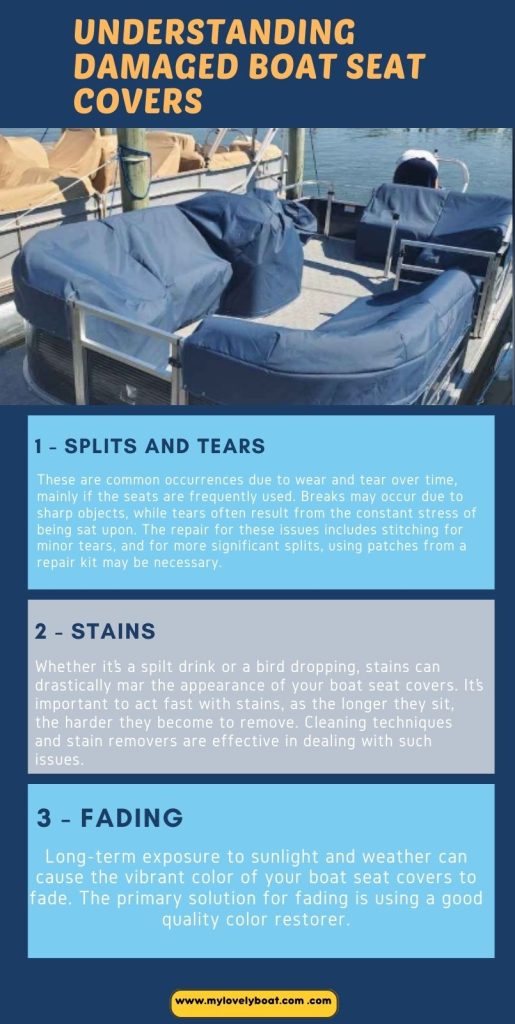Why You Can Trust: We are dedicated to providing our readers with the most comprehensive, expert advice on a wide range of products. If you buy through our links, we may get a commission.
Repairing damaged boat seat covers is essential for maintaining your boat’s aesthetic appeal and comfort.
A well-maintained boat seat cover not only looks great but also ensures the longevity of the seat cushioning, avoiding deterioration and potential mold.
This step-by-step guide will teach you how to repair various types of damage to boat seat cover with the appropriate materials and tools, saving you time and money.
Understanding the Damage

Understanding the type of damage to your boat seat covers is the first step towards their effective maintenance. These damages not only affect the look of the seats but also their durability. Let’s discuss the typical damages that boat seat covers undergo:
- Splits and Tears: These are common occurrences due to wear and tear over time, mainly if the seats are frequently used. Breaks may occur due to sharp objects, while tears often result from the constant stress of being sat upon. The repair for these issues includes stitching for minor tears, and for more significant splits, using patches from a repair kit may be necessary.
- Stains: Whether it’s a spilt drink or a bird dropping, stains can drastically mar the appearance of your boat seat covers. It’s important to act fast with stains, as the longer they sit, the harder they become to remove. Cleaning techniques and stain removers are effective in dealing with such issues.
- Fading: Long-term exposure to sunlight and weather can cause the vibrant color of your boat seat covers to fade. The primary solution for fading is using a good quality color restorer.
Each type of damage needs a different repair approach. Hence understanding the kind of damage helps you choose the right tools and products and execute accurate repair methods.
Tools and Materials Required for Repair
Properly repairing boat seat covers requires specific tools and materials, each with a unique purpose in the restoration process. Here’s a breakdown of what you’ll need:
- Sewing Kit: A basic sewing kit with needles and threads is a fundamental tool. It is handy for fixing minor tears in the seat cover fabric or stitching up loose threads. The line you use should match the color of your seats to maintain a uniform appearance.
- Vinyl Repair Kit: If your boat seat covers are made of vinyl (a standard material for waterside durability), you’ll likely face splits or tears at some point. A vinyl repair kit contains liquid vinyl that can match your seat color and adhesive-backed vinyl patches. The patches provide an ‘invisible’ fix for more significant splits. At the same time, the liquid fills smaller tears and minor holes, making the kit essential.
- Upholstery Cleaner: For dealing with hard-to-clean stains from foods, drinks, or bird droppings, a good upholstery cleaner is crucial. It’s specially designed to be fabric-friendly, ensuring that it cleans without causing further damage to the already vulnerable stained area.
- Color Restorer: Extended exposure to sunlight often leads to faded colors. A color restorer is used to bring back this lost vibrancy, ensuring your seats look as splendid as they used to when new.
- Gloves: Safety is key when dealing with cleaning chemicals or rugged materials. Protective gloves will ensure you maintain your grip while protecting your skin from potential harm.
- Safety Glasses: Tiny particles of your seat cover or the cleaning supplies you use can form a hazard. Safety glasses are handy when scrubbing off stains vigorously or while sewing, as they protect your eyes.
Assembling these tools and materials before commencing your repair job is convenient and provides safety. Being prepared with the correct items boosts the effectiveness of your repair, improving the appearance and durability of your boat seat covers.
Preparing for the Repair
Before diving into the repair process, thorough preparation is crucial to ensure a smooth and effective outcome. Here’s a step-by-step guide on how to prepare for boat seat cover repair.
- Inspect the Seat Cover: Begin with a detailed inspection of your seat cover to identify the type of damage and its extent. Check for multiple damages like splits, tears, stains, and color fading. This will help you identify the appropriate repair method and gather the necessary materials.
- Clean the Seat Cover: Clean the damaged seat covers. Use appropriate cleaning agents to remove dirt, dust, and mild stains. Ensure that your cleaning agent is fabric-friendly to avoid causing further damage. Properly cleaning the covers enables seamless repair and a fresh start for restorations like re-stitching or applying patches.
- Set Up Your Workspace: Your work area should be clean, organized, and well-lit, with enough room to move and work comfortably. Arrange the necessary tools and materials for repair. Remember to make available safety gear, such as gloves and glasses, within easy reach.
- Plan the Repair Process: Depending on the damage type, plan your repair process. List the steps to follow in the order you intend to execute them. This will save time and ensure a systematic approach to cover repair.
Following these steps, you will be prepared to tackle any boat seat cover issues quickly and efficiently. A well-planned repair process ensures quality results and prolongs the life of your boat seat covers.
Step-By-Step Guide to Repairing Boat Seat Covers

Boat seat cover damages vary. While some might involve minor tears or loose threads, others involve significant splits or color fading. Each category requires a different approach to repair. Here are step-by-step instructions for each type of repair.
Repairing Splits and Tears
Splits and tears could get worse if neglected. Here’s how you can fix them:
- Gather Materials: Get your vinyl repair kit, scissors, and a hairdryer.
- Clean the Area: Clean the area around the split or tear to remove dirt or dust.
- Cut and Apply the Patch: Cut a patch from your kit slightly more significant than the tear. Adhere it over the damage, making sure it sticks well on all sides.
- Apply Liquid Vinyl: Apply a small amount of liquid vinyl over the patch to ensure a seamless blend with the boat seat cover.
- Dry the Patch: Use your hairdryer on a low setting to dry the liquid vinyl. Once dry, you’ve successfully repaired a split or tear.
Cleaning and Restoring Faded Colors
Fading is a result of continuous exposure to environmental elements. Here’s how to restore faded colors:
- Gather Materials: You will need a color restorer, an appropriate cleaner, and a sponge or cloth.
- Clean the Seat Cover: Use the appropriate cleaner to remove surface dirt. This gives the color restorer a clean base to work on.
- Apply the Color Restorer: Apply an appropriate amount of the color restorer using a sponge or cloth. Spread it evenly across the faded seat cover.
- Let It Dry: Allow the seat cover to dry. Avoid prematurely using the seat covers to prevent smudging the restorer.
Re-stitching Loose Threads
Loose threads affect the appearance of seat covers and weaken them. Let’s fix this:
- Gather Materials: You need a durable thread and needle sewing kit.
- Thread the Needle: Cut a suitable length of thread. Pass one end through the eye of the needle. Match both ends making the line double, then tie a knot.
- Identify Loose Ends: Identify the start and end points of the loose thread. You will stitch this area together.
- Start Stitching: Push the needle into one endpoint. Pull the thread through until the knot stops it. Weave in and out of the fabric until you reach the other endpoint.
- Secure the Stitch: Trick off the thread with a knot and trim the excess.
With these steps, you can now handle common issues with boat seat covers and restore them to optimal condition.
More Resources:
- The 20 Most Useful Boat Seat Accessories Every Boater Should Consider
- How Do I Protect My New Boat Seats? 7 Secret Tips
- The Ultimate Guide to Boat Seat Covers: Types, Materials, Benefits, and Maintenance
- 7 Simple Tips to Protect Your Boat Seats from Bird Droppings
- Top 23 Must-Have Boat Accessories for Every Boater Need.
- 16 Essential Comfort and Relaxation Boat Accessories
- Top 100+ Romantic Boat Names That Will Make You Fall In Love
FAQ
Can I repair the boat seat covers myself?
Yes, minor damages like small splits, tears, or loose threads can be DIYed with the right tools and materials.
Where to buy boat seat cover repair kits?
Repair kits can be bought from a local marine supply store, an auto parts store or online marketplaces like Amazon and eBay.
How to prolong the lifespan of boat seat covers?
Regular cleaning, repair of minor damages, and appropriate storage can prolong the lifespan of your seat covers.
How do clean boat seat covers before repair?
Clean the boat seat covers with an appropriate cleaner to remove dirt, dust, and stains.
Will repairing my boat seat covers increase the value of my boat?
Maintaining and repairing your boat seat covers can increase resale value by keeping your boat looking new and well-maintained.

I am a freelance writer passionate about watersports and the great outdoors. I have many years of experience in the marine industry, and I enjoy sharing my knowledge and expertise with others so that they can get the most out of their boating experiences. I like fishing, kayaking, and exploring new destinations by boat whenever I have time. Contact Us: Linkedin







